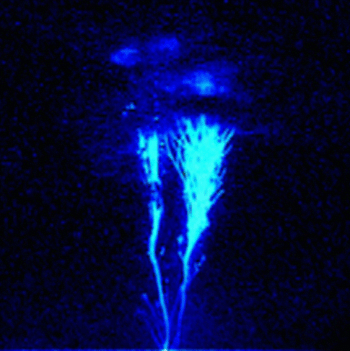A long-standing belief about the way charge is transported through the atmosphere has been confirmed by observations from a group of scientists in the US. Victor Pasko of Pennsylvania State University, Mark Stanley of the New Mexico Institute of Mining and Technology, and colleagues video recorded a ‘blue jet’, a lightning-like flash that extends upwards from thunderclouds. The footage reveals that the blue jets are long enough to link thunderclouds and the charged layer of the upper atmosphere (P Pasko et al 2002 Nature 416 152).

Two types of extensive optical flash have been identified above thunderclouds. ‘Sprites’ – which occur in many shapes – involve the downward movement of charge from the base of the ionosphere at speeds exceeding ten million metres per second. ‘Blue jets’, on the other hand, are conical and are caused by charge travelling upwards from cloud tops at around a hundred thousand metres per second. Their blue colour arises from the ionization of molecules in the atmosphere.
It was suggested more than 80 years ago that such electrical discharges could bridge the gap between a thundercloud and the upper atmosphere. But previous measurements indicated that blue jets could only reach heights of about 40 kilometres. Pasko and colleagues used a low-light video camera at the Arecibo Observatory in Puerto Rico to record images of a blue jet that reached an altitude of about 70 kilometres. This height corresponds to the base of the lower ionosphere’s conducting layer.
The event was recorded in the early hours of 15 September 2001. It spans just 24 video frames and shows the jet travelling upwards and splitting off into two main branches. Successive frames show the branches breaking up into a collection of ‘hotspots’ above an altitude of about 42 kilometres, which corresponds both to the normal maximum height of blue jets and to the lower limit of sprites. At the end of the footage the cloud produces an intense flash of lightning.
The thunderstorm involved was relatively small and localized. Since such storms occur frequently across the world, the researchers speculate that large blue jets are commonplace. The ability to ionize molecules could play a significant role in chemical processes that occur in the atmosphere, such as the growth of nitric oxide and the reduction of ozone. Pasko, however, points out that these effects are probably local rather than global, and still need to be quantified.



